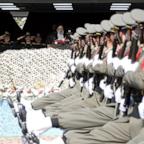Was the Sistine Ceiling a Papal Insult?
Did Michelangelo embed forbidden messages in the frescoes of the famous ceiling?
April 28, 2008— -- For centuries, people of all faiths have come to Rome and the Sistine Chapel to stare up at its immense ceiling and see Michelangelo's stunning masterpiece. To most, it is a beautiful vision from the Old Testament, frescoes painted on wet plaster of the stories of the creation of the universe, Noah's ark and Adam and Eve.
Dr. Arnold Nesselrath, the curator of the Vatican Museums, says people flock to the Sistine Chapel because "it's one of the greatest works of mankind that were ever produced and it's one of the greatest treasures of art."
But there are those who look at the 500-year-old frescoes — and see hidden messages.
"This, here, has so many layers of meaning upon meaning, and most of it, if not all of it, is from the Jewish tradition," says Roy Doliner, a Vatican tour guide. He and Rabbi Benjamin Blech, Associate Professor of Talmud, Yeshiva University, have written a book, "The Sistine Secrets: Michelangelo's Forbidden Messages in the Heart of the Vatican."
They say that Michelangelo embedded powerful and dangerous messages in the frescoes of the Sistine Chapel, that he encoded these messages using his knowledge of ancient Jewish texts, and that he intended some images as insults to the Pope himself.
Rabbi Blech says there's a reason that all the figures on the ceiling are Jews, the ancestors of Christ and Christianity.
"By emphasizing only Old Testament figures in the entire ceiling … what he was trying to say was, why we have ignored our true roots?"
Of course, 16th century Italy was a time and place that was overwhelming Catholic. But the authors say that Michelangelo was pointedly nudging the church to be kinder to Jews. In Florence, where he was raised, the young Michelangelo grew up in the household of the great Renaissance leader Lorenzo de Medici. It was here, the authors believe, that the artist would have been exposed to Judaism and its teachings.
One of the books the Medicis studied was at the center of an ancient form of Jewish mysticism: Kabbalah, as trendy then as it is today.




